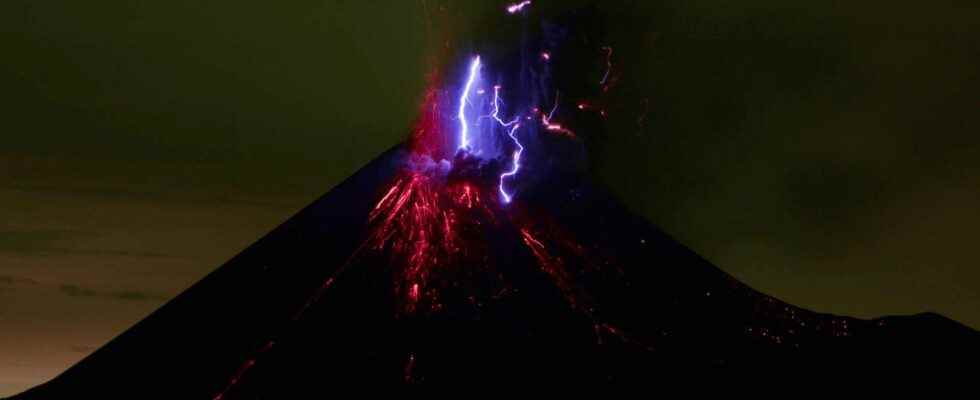You will also be interested
[EN VIDÉO] Interview: the three biggest volcanic eruptions in history Volcanologists are constantly confronted with volcanic eruptions. However, some are particularly brutal or intense. Futura-Sciences met Jacques-Marie Bardintzeff, doctor in volcanology, to find out what are the three largest known volcanic eruptions.
Phenomenon, oh so spectacular! adding power to images that often do not lack it, these volcanic lightning are, however, still poorly understood. And for good reason, the study of the phenomenon is complicated by the volcanic phenomenon itself!
This being so, the mechanism seems to be based on the same principle as for lightning more classic. During a thunderstorm, theair ascending heat up to high altitudes allows the formation of ice crystals from water vapor, crystals that grow in size until they form grains of sleet and which, as they are heavy, migrate towards the base of the cumulonimbus. This fall of sleet, associated with movements of air within the cloud, generates collisions between the particles: the sleet extracts negative charges from the ice crystals which, as a result, become positively charged. The latter accumulate in the upper part of the cloud, while the negative charges are concentrated in its lower part, causing a significant potential difference. Discharges then end up being created between the two ends of the cloud, or towards the ground for that matter, the violent heating of the air generated during these being at the origin of the luminous phenomenon: lightning.
In a volcanic plume, the formation of charged particles occurs in at least two different ways. Near the eruptive mouth first, whether through the friction between magmatic ash particles or by their fracturing. And higher in altitude, by the shocks between the sleet, the ash particles and the ice crystals, exactly as during stormy episodes, the water being abundant in the plumes eruptive since it is the gas main volcano.
But how do these charges separate? Because in these eruptive columns, the movement is essentially upward due to the flow of heatand if the separation loads by gravity in the upper part of these can generate “storm” type lightning, this mechanism cannot explain the many flashes that form at the base of volcanic plumes! Some scientists thus offer the turbulence generated by gases allows the formation of clusters of positively or negatively charged particles… There is still a lot to understand!
Explosions at the top of Krakatau in Indonesia, with intra-plume lightning. © 80 Days Travel, Sylvain Chermette
Why so many lightnings on January 15 in Tonga?
the eruptive dynamism and the power of the eruption from Hunga Tonga-Hunga Ha’Apai probably explain the impressive quantity of lightning produced on January 15. In fact, the dynamism surtseyen, which results from an underwater eruptive vent in shallow water, is particularly explosive. It therefore generated very fine ash particles and a considerable amount of water vapour, two elements which very clearly promote the phenomenon. Moreover, the power of the eruption allowed this eruptive plume to rise to very high altitudes, where temperatures are very low and volcanic water vapor freezes easily. It therefore seems that this eruption met a number of conditions favoring the formation of lightning.
Lightning strikes in the January 15 eruptive plume from the Hunga Tonga-Hunga Ha’Apai volcano. © William Churchill
Prior to this eruption, the record number of volcanic flashes spotted by the global lightning of Vaisala was held by the eruption of the Krakatau in 2018. Some 340,000 flashes had been produced in one week… During the eruption in Tonga, 590,000 flashes were counted in three days, including 400,000 in just six hours at the time of the paroxysm, on January 15. 18 every second: amazing!
56% of these lightning strikes the surface, ocean or land, which is ” higher than what you would normally see in a typical thunderstorm, and higher than what you typically see in volcanic eruptions, which creates some interesting research questions “, according to Chris Vagasky, meteorologist at Vaisala. On Tongatapu, the main island ofarchipelago, 1,300 lightning strikes were recorded during this episode, against only a few hundred per year usually. With the ash falls, the waves of the tsunami and lightning: the moment experienced by the Tongans must have been daunting!
Tonga: The eruption of the submarine volcano Hunga Tonga-Hunga-Ha’apai resulted in volcanic thunderstorms observed in the volcanic plume or at its periphery. They occur when dust and/or gas plumes become electrically charged & produce lightning. pic.twitter.com/IPEFLzOvlC
— Rebecca Rambar (@RebeccaRambar) January 16, 2022
Numerous lightning during the paroxysm of the January 15, 2022 eruption of the Hunga Tonga-Hunga Ha’Apai volcano. © Rebecca Rambar
Interested in what you just read?
